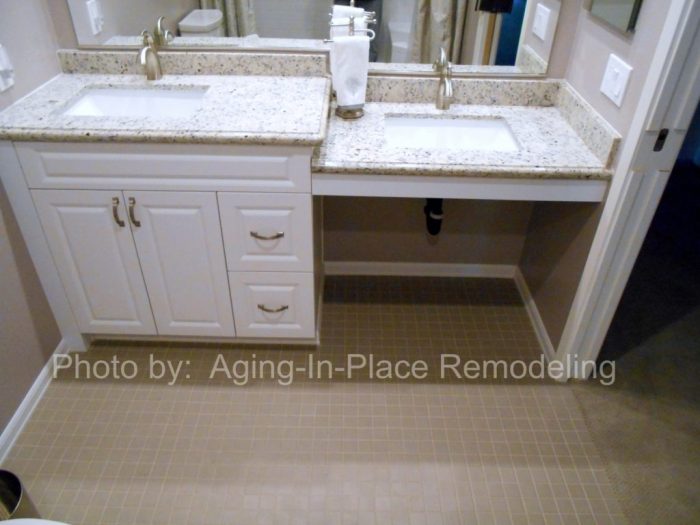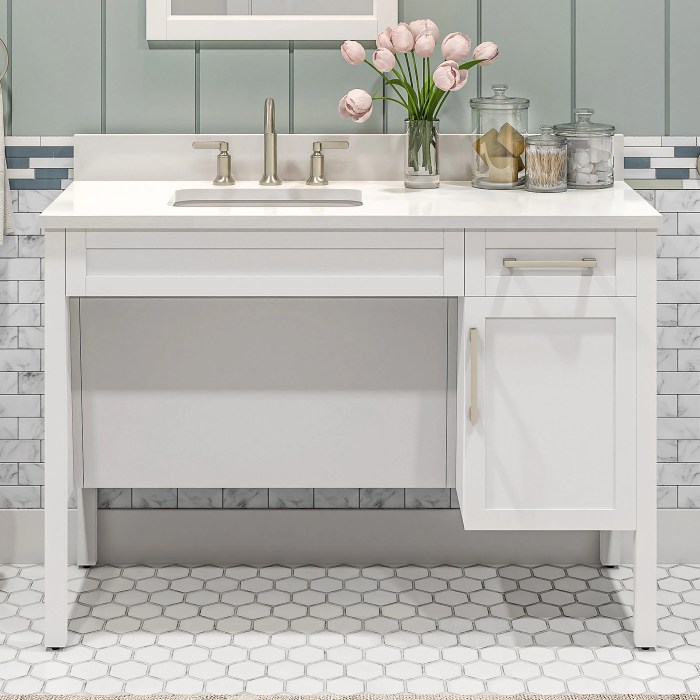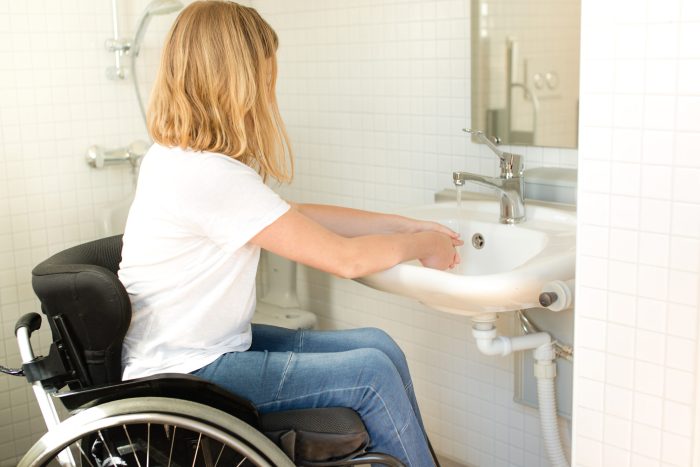Bathrooms, often overlooked in accessibility discussions, play a pivotal role in our daily lives. For individuals with disabilities or mobility challenges, bathroom design becomes paramount, necessitating innovative solutions like adjustable height bathroom vanities. These vanities offer a transformative approach to bathroom accessibility, empowering users with customized comfort and functionality.
Adjustable height bathroom vanities transcend the limitations of traditional bathroom fixtures, providing a tailored experience that caters to diverse needs. They not only enhance accessibility but also promote independence and dignity, allowing individuals to maintain their daily routines with ease and confidence.
Adjustable Height Bathroom Vanities
In the realm of bathroom design, accessibility plays a pivotal role in ensuring comfort and convenience for individuals with disabilities or mobility challenges. Adjustable height bathroom vanities emerge as a cornerstone of accessible bathroom design, offering a myriad of benefits that cater to the unique needs of these individuals.
Adjustable height bathroom vanities empower users to customize the height of their vanity to an optimal level that suits their physical capabilities. This adaptability allows for easy access to the sink, mirror, and other vanity components, reducing strain and discomfort during daily routines.
Moreover, the adjustable height feature enables multiple users with varying heights to utilize the vanity comfortably, promoting inclusivity and ease of use for all.
Types of Adjustable Height Bathroom Vanities
The market offers a diverse range of adjustable height bathroom vanities, each designed to meet specific needs and preferences:
- Manual Adjustable Vanities: These vanities feature a hand crank or lever mechanism that allows users to manually adjust the height of the vanity.
- Electric Adjustable Vanities: These vanities utilize an electric motor to effortlessly adjust the height of the vanity at the touch of a button.
- Wall-Mounted Adjustable Vanities: These vanities are mounted to the wall, allowing for a more flexible height adjustment range compared to floor-standing models.
- Sit-Stand Adjustable Vanities: These vanities incorporate a wider height range, enabling users to transition from a seated to a standing position while using the vanity.
Design Considerations for Adjustable Height Vanities
The design of adjustable height bathroom vanities requires careful consideration to ensure they meet the diverse needs of users. Key factors to consider include height range, weight capacity, and stability.
Height Range
The height range of an adjustable vanity determines the extent to which it can be raised or lowered to accommodate different users. The ideal height range will depend on the height of the user and the intended use of the vanity.
For example, a vanity used for wheelchair accessibility may require a wider height range than one used for occasional use.
Weight Capacity
The weight capacity of an adjustable vanity refers to the maximum weight it can support. This is important to consider, especially for vanities that will be used to support heavy items such as wheelchairs or medical equipment.
Stability
The stability of an adjustable vanity is crucial for safety and ease of use. The vanity should be designed to remain stable at all heights, even when subjected to forces such as pushing or pulling.
Adjustment Mechanisms
Adjustable height vanities typically use one of two mechanisms for adjusting the height: manual or motorized.
Manual adjustment: Manual adjustable vanities require the user to physically adjust the height by turning a crank or lever. This option is generally more affordable but may require more effort to adjust.
Motorized adjustment: Motorized adjustable vanities use an electric motor to adjust the height. This option is more convenient but can be more expensive.
User Considerations
When selecting an adjustable height vanity, it is essential to consider the specific needs and preferences of the user. Factors to consider include the user’s height, weight, mobility, and any special requirements such as wheelchair accessibility.
Materials and Finishes for Adjustable Height Vanities
Adjustable height bathroom vanities offer a range of material and finish options to suit various needs and preferences. Understanding the characteristics of these materials and finishes helps in making informed choices for durability, water resistance, and aesthetics.
Materials
- Wood: Solid wood or wood veneers provide a natural and durable option. However, they require regular sealing to protect against moisture.
- Metal: Stainless steel or aluminum vanities are highly durable and water-resistant, making them ideal for wet environments. They offer a sleek and modern look.
- Laminate: Laminate surfaces are affordable, moisture-resistant, and available in a wide range of colors and patterns.
Finishes
Finishes enhance the aesthetics and protect the vanity surface.
- Paint: Paint provides a customizable and cost-effective finish. It is available in various colors and finishes, but requires touch-ups over time.
- Stain: Stains penetrate the wood, enhancing its natural grain and providing a durable finish. They require regular reapplication to maintain their appearance.
- Veneer: Veneers are thin layers of wood applied to a substrate. They offer the look of real wood at a lower cost, but are less durable than solid wood.
Installation and Maintenance of Adjustable Height Vanities
Proper installation and maintenance of adjustable height bathroom vanities are crucial to ensure their safety, functionality, and longevity. This section provides detailed guidance on installing and maintaining these vanities to optimize their performance and extend their lifespan.
Step-by-Step Installation
Installing an adjustable height bathroom vanity involves several steps, each requiring precision and attention to detail.
- Preparation: Determine the desired height of the vanity and ensure that the wall can support its weight. Mark the mounting points and gather the necessary tools and materials.
- Mounting: Attach the mounting brackets to the wall according to the manufacturer’s instructions. Ensure that the brackets are level and securely fastened.
- Plumbing Connections: Connect the vanity to the water supply and drainage system. Use flexible hoses to allow for height adjustments.
Importance of Proper Installation
Proper installation is essential for the safe and reliable operation of adjustable height vanities. It ensures that:
- The vanity is securely mounted and can withstand daily use.
- Plumbing connections are watertight and prevent leaks.
- The vanity operates smoothly and adjusts to the desired height without difficulty.
Routine Maintenance
Regular maintenance is crucial to keep adjustable height vanities in optimal condition. This includes:
- Cleaning: Clean the vanity surfaces with a mild detergent and water. Avoid using harsh chemicals or abrasive cleaners.
- Lubrication: Lubricate the adjustment mechanisms periodically to ensure smooth operation and prevent wear.
- Periodic Inspections: Regularly inspect the vanity for any signs of damage, loose connections, or leaks. Address any issues promptly to prevent more significant problems.
Safety Features and Regulations for Adjustable Height Vanities
Adjustable height bathroom vanities prioritize safety and accessibility, incorporating features that prevent accidents and enhance user comfort.
Anti-Tip Mechanisms
Anti-tip mechanisms are essential safety features that prevent the vanity from tipping over when excessive weight is applied. These mechanisms include:-
- Rear stabilizers that extend from the back of the vanity and provide additional support.
- Anchoring devices that secure the vanity to the wall, ensuring stability.
Grab Bars
Grab bars are crucial for individuals with mobility limitations, providing support and stability when entering, exiting, or using the vanity. They are typically installed near the sink and toilet for easy access.
Building Codes and Regulations
Building codes and regulations govern the installation and use of adjustable height vanities to ensure safety and accessibility. These regulations vary by jurisdiction but generally address:-
- Height adjustability requirements to accommodate different user needs.
- Clearance space around the vanity for wheelchair access.
- Grab bar placement and specifications.
- Anti-tip device requirements.
Adhering to these regulations is essential to ensure compliance, user safety, and the creation of an accessible bathroom environment.
Design Examples and Case Studies
Adjustable height bathroom vanities offer a versatile and accessible solution for bathrooms of all sizes and needs. By showcasing design examples and case studies, we can gain valuable insights into their functionality and aesthetics.
The design of adjustable height vanities prioritizes ergonomics, functionality, and style. These vanities are often equipped with adjustable legs or bases that allow users to customize the height to suit their individual needs. They may also feature pull-out shelves, drawers, and compartments to maximize storage and accessibility.
Design Gallery
Here’s a gallery of visually appealing and functional design examples of adjustable height bathroom vanities:
- A modern bathroom with a sleek, floating adjustable height vanity. The vanity features a clean-lined design with ample storage space, including drawers and shelves.
- A traditional bathroom with a classic adjustable height vanity. The vanity is made of wood with a rich finish and features intricate detailing and a spacious countertop.
- A small bathroom with a compact adjustable height vanity. The vanity is designed to fit into tight spaces and features a minimalist design with a single sink and a few drawers.
Case Studies
Case studies provide real-world examples of the successful implementation of adjustable height bathroom vanities in accessibility projects:
- A case study of a hospital bathroom renovation that included the installation of adjustable height vanities. The vanities were designed to meet the needs of patients with varying heights and mobility levels.
- A case study of a school bathroom renovation that included the installation of adjustable height vanities. The vanities were designed to accommodate students of all ages and abilities.
- A case study of a home bathroom renovation that included the installation of adjustable height vanities. The vanities were designed to meet the needs of an aging homeowner who wanted to maintain independence in their bathroom.
These case studies demonstrate the versatility and functionality of adjustable height bathroom vanities. They also highlight the importance of considering design principles and best practices when selecting and installing these vanities.
Future Trends and Innovations in Adjustable Height Vanities
The realm of adjustable height bathroom vanities is poised for transformative advancements, driven by technological innovation and a relentless pursuit of accessibility and convenience.
Smart Technology Integration
The integration of smart technology promises to revolutionize the functionality of adjustable height vanities. Voice control will empower users to effortlessly adjust the vanity’s height, activate features, and even access information hands-free. Remote monitoring capabilities will allow caregivers or family members to remotely monitor the vanity’s usage and ensure the well-being of loved ones.
Advanced Materials and Designs
Emerging materials and innovative designs will enhance the durability, aesthetics, and accessibility of adjustable height vanities. Lightweight, high-strength materials will enable the creation of vanities that are both robust and easy to maneuver. Ergonomic designs will prioritize comfort and support, ensuring a safe and comfortable experience for users of all abilities.
Personalized Accessibility
Future advancements will focus on tailoring adjustable height vanities to individual needs and preferences. Sensors and AI algorithms will analyze usage patterns and automatically adjust the vanity’s height to optimize comfort and accessibility. Custom profiles will allow users to save their preferred settings, ensuring a seamless and personalized experience.
Sustainable Solutions
Sustainability will play a pivotal role in the future of adjustable height vanities. Eco-friendly materials and energy-efficient designs will minimize environmental impact. Water-saving features, such as low-flow faucets and dual-flush toilets, will contribute to water conservation.
Enhanced Safety Features
Safety remains a paramount concern in bathroom design. Future innovations will enhance the safety of adjustable height vanities. Anti-slip surfaces, motion sensors, and emergency call buttons will provide peace of mind for users and their caregivers.
Final Thoughts
As we delve deeper into the realm of adjustable height bathroom vanities, we uncover a world of design possibilities and technological advancements. From the choice of materials and finishes to the integration of smart technology, these vanities are poised to revolutionize bathroom accessibility.
They represent a testament to the power of design in creating inclusive and empowering spaces that foster well-being and dignity for all.



